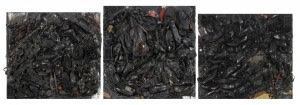 |
| John Blackburn, And God Cryed, 2011-12 |
It was with great delight that I returned
to work last week to find the walls of the Jarman building covered from top to
bottom like never before with abstract paintings. And moreover, these were paintings
that, even if they were not outside my office door, I would want to spend time
with them. Because the 88 paintings
covering every spare inch of wall space in Jarman move along the spectrum of
black to grey to white, they push at the boundary that lies between abstraction
and figuration, and in all their variety, they carry the viewer through a whole gamut of viewing possibilities.
 |
| Jarman Building, Ground Floor filled with Blackburn paintings |
And
God Cryed exhibits the vastness and diversity of paintings
made by contemporary British painter, John Blackburn. In a film made to accompany the exhibition, Blackburn adamantly reinforces that Scott (presumably British
Abstract painter William Scott) has no influence on his thinking or aesthetic.
And what’s unique about the works is that in the very same moment that we see
Rothko, Rothko disappears. Of all the Americans, as I walked around the
building, I wanted to make the connection to Rauschenberg’s combines, and then
in the very next moment I saw Twombly everywhere in the large drips, scribbles
and scrawls. And yet, like the gesture towards Rauschenberg or Rothko, Pollock
or British artists such as Scott, Twombly is somehow both there and not there
on the canvas or wooden support. My temptation to connect the paintings to what
I know, and their insistence on eluding that connection is indicative of their
innovation.
 |
| Jarman Building, Mezzanine |
The very same could be said of the shifting
vicissitudes of the paintings themselves. The dense conglomerations that
are the black paintings with appropriated texts are all but dark and depressing,
that is, just until, up close we trace a thread of red paint as it weaves
through a clump of black. Again and again, a thread of color becomes the light
and hope that consciously always gets caught up on the surface of Blackburn’s
paintings. Things, literal things, find their way onto these paintings and together with the words that
striate the surface, like graffiti left on a dilapidated gravestone, the hair, the
shoes, pieces of paper, and all manner of things get caught up in the
dense, dark coagulations of black paint. These things might make the works physically heavy and gothic, but they also relieve the paint of its darkness. The presence of the
everyday on these surfaces simultaneously reveals their familiarity.
 |
| John Blackburn, No No, 2012 |
In the film, Blackburn is unequivocal in
his explanation of the bleakness of his paintings. He says they are about life,
and that “life itself is terribly dangerous, terribly cruel, terribly rewarding”.
He says without blinking “The human condition drives my work. I would be lost …
without that.” For all of the density of the paint, the intensity of the
buildup on the canvas, there is a precariousness to these paintings. The wires
that protrude form Five Forms Imprisoned
(2010) echo the chilling pain of incarceration, hiding behind its bars the
tenderness of human emotional turmoil. And the drips of Tin Bath, 2005 remind me of tears, shed by the inability to be
comforted in a time of trauma.
 |
| John Blackburn, Black/White/Grey, 2007 |
When he describes the gothic black paintings, Blackburn says, again
without flinching “The actual reality is that man never learns anything. There
is still the same amount of treachery and evil” and here he most obviously
refers to the presence of war and agression in the paintings. All of those who
died on the battlefield in the world war that began when Blackburn was 7 years
old seem to be remembered on the surfaces. As well as the
memories, caught in the brushstroke, the burnt paint, distressed surfaces and
aged, mangled objects, there is a resounding melancholy. And in this gesture, the
works become figurative. They sit on the precipice between aesthetic abstraction,
and the emotions tied to memory that lead them into
the realm of figuration. They are angry, sad, surprising, moving, holding
up mirrors to the breadth of our emotions –
 |
| John Blackburn, Black Shoe Trilogy, 2011-12 |
One of the greatest joys of having the
paintings in Jarman comes as I catch one of my colleagues contemplating a
painting, having been stopped in his or her tracks on the way to a meeting
somewhere else in the building. It’s difficult not to get caught up in the
drama and provocation of the work because the paintings are the object of our
look no matter where we turn. What I love most about the
exhibition is that the paintings are integrated into the day to day life of the
building. We hold parties on the mezzanine, teach on the first floor, the
gallery spaces host events and talks, drama students are in the habit of
lurking through the building making strange noises as they practice their
performances, and the students sit around talking throughout the day on the ground
floor. Blackburn’s paintings participate in every activity. When I asked Ben
Thomas, my colleague and exhibition curator, what was going to happen when
pieces of bubble gum found their way into one of the shoes in the Black Shoe Trilogy,
he shrugged his shoulders and said “it’s not a problem, I think John is quite
happy for that to happen.”
All images courtesy of the Artist
No comments:
Post a Comment